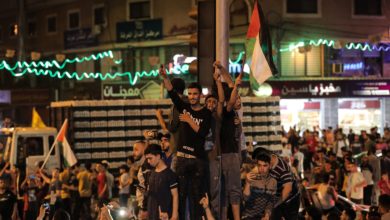The United States unleashed one of the largest bombing campaigns of the war on a populous Baghdad suburb on Jan. 10. The stated targets were “defensive belts” of resistance south of the capital. Before the bombing, Iraqi resistance forces were said to have controlled Arab Jabour, a principally Sunni district, lined with citrus groves. A U.S. military spokesman, Major Alayne Conway, said that the operation “was one of the largest air strikes since the onset of the war.” The blasts were seen and felt throughout Iraq’s sprawling capital city.
Two B1-B bombers and four F-16 fighter jets dropped nearly 50,000 pounds of precision-guided explosives on 47
 |
Witnesses said that at least 40 civilian homes and the main road in and out of the village had been completely destroyed. People were believed to be trapped under the rubble of the ruined buildings, while others were said to be unable to reach medical care because of damage to the road.
American officials deemed the operation “a success,” allowing U.S. soldiers to push into areas they had not occupied in years. According to Army Col. Terry Ferrell, the “predominant number” of local resistance forces have been killed or scattered to the southwest.
One alleged trigger for air assault was the death of six U.S. troops and an Iraqi interpreter on Jan. 9 in Diyala province, when a blast tore through an explosives-laden house. Desperate to reduce such casualties, the U.S. military has broadly expanded its use of air strikes. In 2007, there were at least 1,119 air strikes, according to the U.S. Air Force, compared with 229 the previous year.
An Iraqi army officer confirmed that air strikes had led to the burning of citrus groves as well as the destruction of homes. Moahmoud Chiad, a resident of Arab Jabour, told the Associated Press that many military checkpoints had been set up in the town and that people were being ordered through loudspeakers to stay home.
The air attack was followed by a deadly ground assault by the U.S. occupiers and Iraqi puppet forces. In house-to-house fighting, dozens of remaining Iraqi resistance fighters were captured, along with weapons and documents.
Before the war, Abu Jubour was well known for its complex, centuries-old irrigation systems fed by the Tigris River, which supplied numerous citrus orchards. Following the U.S. imperialist invasion in 2003, it was a natural base for the Iraqi resistance. It was close to the capital, the population was sympathetic, and the terrain made operations by U.S. armored vehicles difficult. The area is now a wasteland of bombed-out buildings, dried-up irrigation channels and abandoned fields.
The intensification of violence coincided with the release of a World Health Organization study that estimated that at least 151,000 Iraqis had suffered “violent” deaths in the war between March 2003 and June 2006. The study was greeted with relative approval from war supporters as it estimated fewer casualties than a previous Johns Hopkins University study published in the British medical journal Lancet. That study, covering the same period, put the number of Iraqi deaths at over 600,000, and included those who died from the many privations of the occupation outside of direct violence. Since the release of the Lancet study, 18 more months of deadly war have passed, and the death toll is likely to now be over one million. The WHO figure is far too low, but it still confirms an essential and shocking fact: that at least hundreds of thousands of Iraqi civilians were killed in the first three years of an entirely unprovoked and criminal war.
Indeed, the assault was part of a nationwide offensive called Phantom Phoenix, launched by U.S. troops and Iraqi puppet forces. Its name strangely echoes Vietnam’s Operation Phoenix. In that operation, the CIA orchestrated death squads that summarily murdered tens of thousands of Vietnamese people. That operation was one of the most savage acts of the lengthy U.S. occupation.
It is similarly interesting to note that the explosive force dropped in the attack last week was roughly equal to the payload of American B-52’s used in the “carpet bombing” of Vietnam. The tactic was principally designed to reduce American casualties while also destroying the material basis of Vietnamese society. The tactics were adopted in the face of clear defeat during the latter stages of that war.
The bombing and its historical parallels are clear indication that the Washington is still desperate to prevent the appearance of a catastrophic defeat in Iraq at the hands of an armed Arab resistance.
The intensification of the war must be greeted by more than simply horror and indignation. It must be matched by an intensification of the movement against the war. As we approach the fifth anniversary of the imperialist invasion of Iraq, all progressive forces must speak in a single voice: “End the war now!”





